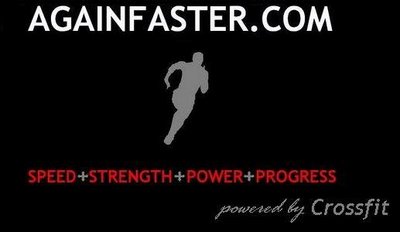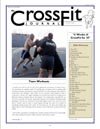More Power

From "Foundations":
"At Crossfit 'power' is the undisputed king of performance. Power is, in the simplest terms, 'hard and fast.' Jumping, punching, throwing, and sprinting are all measures of power. Increasing your ability to produce power is necessary and nearly sufficient to elite athleticism. Additionally, power is the definition of intensity, which in turn has been linked to nearly every positive aspect of fitness."
Physics defines power as work/time.
The components of the work calculation are straight-forward: load, distance, and angle of displacement. I know Sam is going to skim this if I start with cosines and the like, so we'll keep this basic.
For all of the numbers I'm about to present, I used the following assumptions:
1.) Our subject (me) is 5'10" and weights 165 pounds.
2.) The guys at Performance Menu did a good job putting together their power output calculator.
That's it. Today, were relying on the Performance Menu Power Output Calculator to do the dirty work.
There are two ways the body produces energy--aerobically and anaerobically. The former uses oxygen, while the latter does not. These two pathways can be further classified.
The anaerobic energy pathway consists of the phosphagen pathway and the glycolitic pathway. The phosphagen pathway dominates energy production for activities lasting up to ten seconds. The glycolitic pathway dominates activities lasting between 10 seconds and two minutes. For both, the activities in question tend to be high power/low volume.
The aerobic energy pathway is also known as the oxidative pathway. It dominates activities lasting over two minutes. These activities tend to be low power/high volume.
We know that power is king. For the sake of illustration, we'll examine the power output of three exercises, each performed under a variety of conditions.
Pullups can be perfomed with weight or without (bodyweight). Weighted pullups are typically performed in short sets with high weight. Bodyweight pullups can be sustained for much longer.
(Pathway/Time/Weight/Reps)
Phosphagen, 10 seconds, +85 pounds, 2 reps: 123.85 watts
Glycolitic, 2 minutes, bodyweight, 30 reps: 99.05 watts
Oxidative, 10 minutes, bodyweight, 100 reps: 66.03 watts
Obviously, we have a huge difference in power output among the three efforts. Power output is much greater (almost double) in the phosphagen/ATP pathway than in the oxidative/aerobic pathway.
It's not a fluke. Check out thrusters.
(Pathway/Time/Weight/Reps)
Phosphagen, 10 seconds, 165 pounds, 3 reps: 332.95 watts
Glycolitic, 2 minutes, 95 pounds, 21 reps: 132.1 watts
Oxidative, 4 minutes, 45 pounds, 50 reps: 104.45 watts
Again, we see more power generation using high weight/low volume efforts than in moderate weight/high volume efforts.
Power production should not be your only concern as an athlete. We're also concerned with developing exceptional work capacity. This is the ability to sustain a specific power output over long durations of time.
Let's see this in action with the squat.
(Pathway/Time/Weight/Reps)
Phosphagen, 10 seconds, 195 pounds, 2 reps: 169.96 watts
Glycolitic, 2 minutes, bodyweight, 50 reps: 104.71 watts
Oxidative, 4 minutes, bodyweight, 100 reps: 104.71 watts
It isn't a typo. In this scenario, the athlete has sustained a constant level of power output in two different energy systems. This is work capacity.
You'll need to develop both power and work capacity to become an elite athlete. As such, you should always be cognizant of your ability to generate power. If you spend the majority of your time doing low weight/high volume exercise, you won't develop the ability to apply power, even as your work capacity increases.
You won't be able to perform athletically, because you won't be able to apply power to the ground or to an external object. In short, the competition will run you over.
Develop power by working in the phosphagen energy pathway. One-rep maximums and 3 by 3s are a great way to do this. Don't neglect this aspect of your training.
Develop work capacity by blending anaerobic and aerobic efforts. For instance, do Fran (21-15-9, 95# thrusters, pullups). This effort combines the phosphagenic, glycolitic and oxidative pathways into a single session, allowing you to develop power across all three.
Crossfit does an exemplary job of developing power and work capacity, as it throws all three pathways into a blender and hits "pulverize" on a regular basis. We also utilize specific power sessions, commonly known as Max Effort Days.
The Performance Menu Power Output Calculator makes it easy to track your power generation. Regardless of the pathway you're in, strive to generate more power every time you tackle a workout. At Crossfit, we do this naturally, by moving more weight in the same time or doing the same workout in less time.
We're stressing the use of a training log for all the athletes at Crossfit Boston and Again Faster, and it's a good idea for anyone who's serious about training.
Keep track of your workouts, times, and loads, and if you're feeling ambitious, do some quick power output calculations. You'll have a map of your progress, and a great tool for optimizing recovery and program design.
In the end, 'power is the undisputed king of performance.' Develop more power, and keep track of your efforts.
If nothing else, you'll have proof for the fish stories you tell the grandkids.
Go faster!
Photo of Tim Allen, a.k.a. "The Toolman" courtesy of joejoe.de

From "Foundations":
"At Crossfit 'power' is the undisputed king of performance. Power is, in the simplest terms, 'hard and fast.' Jumping, punching, throwing, and sprinting are all measures of power. Increasing your ability to produce power is necessary and nearly sufficient to elite athleticism. Additionally, power is the definition of intensity, which in turn has been linked to nearly every positive aspect of fitness."
Physics defines power as work/time.
The components of the work calculation are straight-forward: load, distance, and angle of displacement. I know Sam is going to skim this if I start with cosines and the like, so we'll keep this basic.
For all of the numbers I'm about to present, I used the following assumptions:
1.) Our subject (me) is 5'10" and weights 165 pounds.
2.) The guys at Performance Menu did a good job putting together their power output calculator.
That's it. Today, were relying on the Performance Menu Power Output Calculator to do the dirty work.
There are two ways the body produces energy--aerobically and anaerobically. The former uses oxygen, while the latter does not. These two pathways can be further classified.
The anaerobic energy pathway consists of the phosphagen pathway and the glycolitic pathway. The phosphagen pathway dominates energy production for activities lasting up to ten seconds. The glycolitic pathway dominates activities lasting between 10 seconds and two minutes. For both, the activities in question tend to be high power/low volume.
The aerobic energy pathway is also known as the oxidative pathway. It dominates activities lasting over two minutes. These activities tend to be low power/high volume.
We know that power is king. For the sake of illustration, we'll examine the power output of three exercises, each performed under a variety of conditions.
Pullups can be perfomed with weight or without (bodyweight). Weighted pullups are typically performed in short sets with high weight. Bodyweight pullups can be sustained for much longer.
(Pathway/Time/Weight/Reps)
Phosphagen, 10 seconds, +85 pounds, 2 reps: 123.85 watts
Glycolitic, 2 minutes, bodyweight, 30 reps: 99.05 watts
Oxidative, 10 minutes, bodyweight, 100 reps: 66.03 watts
Obviously, we have a huge difference in power output among the three efforts. Power output is much greater (almost double) in the phosphagen/ATP pathway than in the oxidative/aerobic pathway.
It's not a fluke. Check out thrusters.
(Pathway/Time/Weight/Reps)
Phosphagen, 10 seconds, 165 pounds, 3 reps: 332.95 watts
Glycolitic, 2 minutes, 95 pounds, 21 reps: 132.1 watts
Oxidative, 4 minutes, 45 pounds, 50 reps: 104.45 watts
Again, we see more power generation using high weight/low volume efforts than in moderate weight/high volume efforts.
Power production should not be your only concern as an athlete. We're also concerned with developing exceptional work capacity. This is the ability to sustain a specific power output over long durations of time.
Let's see this in action with the squat.
(Pathway/Time/Weight/Reps)
Phosphagen, 10 seconds, 195 pounds, 2 reps: 169.96 watts
Glycolitic, 2 minutes, bodyweight, 50 reps: 104.71 watts
Oxidative, 4 minutes, bodyweight, 100 reps: 104.71 watts
It isn't a typo. In this scenario, the athlete has sustained a constant level of power output in two different energy systems. This is work capacity.
You'll need to develop both power and work capacity to become an elite athlete. As such, you should always be cognizant of your ability to generate power. If you spend the majority of your time doing low weight/high volume exercise, you won't develop the ability to apply power, even as your work capacity increases.
You won't be able to perform athletically, because you won't be able to apply power to the ground or to an external object. In short, the competition will run you over.
Develop power by working in the phosphagen energy pathway. One-rep maximums and 3 by 3s are a great way to do this. Don't neglect this aspect of your training.
Develop work capacity by blending anaerobic and aerobic efforts. For instance, do Fran (21-15-9, 95# thrusters, pullups). This effort combines the phosphagenic, glycolitic and oxidative pathways into a single session, allowing you to develop power across all three.
Crossfit does an exemplary job of developing power and work capacity, as it throws all three pathways into a blender and hits "pulverize" on a regular basis. We also utilize specific power sessions, commonly known as Max Effort Days.
The Performance Menu Power Output Calculator makes it easy to track your power generation. Regardless of the pathway you're in, strive to generate more power every time you tackle a workout. At Crossfit, we do this naturally, by moving more weight in the same time or doing the same workout in less time.
We're stressing the use of a training log for all the athletes at Crossfit Boston and Again Faster, and it's a good idea for anyone who's serious about training.
Keep track of your workouts, times, and loads, and if you're feeling ambitious, do some quick power output calculations. You'll have a map of your progress, and a great tool for optimizing recovery and program design.
In the end, 'power is the undisputed king of performance.' Develop more power, and keep track of your efforts.
If nothing else, you'll have proof for the fish stories you tell the grandkids.
Go faster!
Photo of Tim Allen, a.k.a. "The Toolman" courtesy of joejoe.de




















0 Comments:
Post a Comment
<< Home